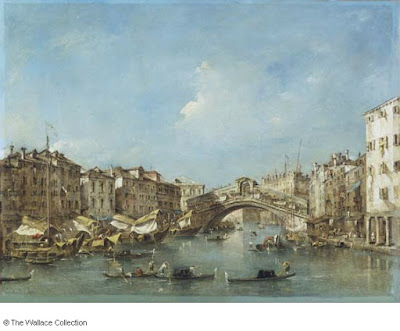Having recently made arrangements for a trip to Venice later this year in November, I found myself distracted by thoughts of things Venetian, and the painters who depicted the city.
Canaletto (1697 -1768). Venice: the Riva degli Schiavoni. c 1740 - 1745. Oil on canvas. 58.2 x 93.5 cm. Wallace Collection
His main market were the young English aristocrats who visited Venice as part of the Grand Tour, that 18th century equivalent of the gap year undertaken by the young toffs of the period as part of their education, in which, accompanied by a tutor, they visited the great European capitals and centres of culture to round off their education as gentlemen and have a bit of fun as well, before returning to England to do the things that aristos of the period did.
In an age before photography and holiday snaps, if you wanted a visual reminder of your once-in-a-lifetime tour of the continent, then you needed a painting, and if it was Venice, then Canaletto was your man. There were other Venetian view painters, of course, many of whom were extremely accomplished, but none of them were as successful.
Which brings us to Francesco Guardi (1712 - 1793), the last of the great view painters of the Venetian Republic. The son of a painter, and one of three brothers who were also painters, he became a view painter and no doubt sought to emulate Canaletto's commercial success, but despite some major commissions, he never really made it big, partly due to a decline in foreign tourism, and partly due to changing artistic tastes. He developed a style quite distinct from Canaletto, with architecture less precisely delineated, and a rather sketchy manner.
Francesco Guardi (1712 - 1793). Venice: San Giorgio Maggiore with the Guiudecca. c.1770s. Oil on canvas. 35.2 x 54.7 cm. Wallace Collection
Although unfashionable during his own time, he became highly regarded from around the middle of the nineteenth century, coinciding with a change in artistic sensibilities, and new developments in art with the emergence of painters like Turner, and later the Impressionists. Perhaps the invention of photography also made a difference to the value placed on strict realism.
I do like and admire Canaletto's pictures, but in many respects Guardi is more more to my taste. Although less polished than Canaletto, his pictures have a sense of movement and vitality which makes many Canalettos seem a bit unexpressive by comparison.
If you want to see paintings by Canaletto and Guardi, you could do worse than to visit the Wallace Collection in London where, in West Gallery I, views of the same locations in Venice by the two artists are displayed together, a rare opportunity to compare works by the two masters.
Here are just two examples, the same scene depicted by Guardi and Canaletto.
Francesco Guardi (1712 - 1793). Venice: the Grand Canal with the Riva del
Vin and the Rialto Bridge c. 1770. Oil on canvas. 68.5 x 91.5 cm. Wallace Collection
Canaletto (1697 - 1768). Venice: the Grand Canal from the Palazzo Dolfin-
Manin to the Rialto Bridge. c. 1740 – 1750. Oil on Canvas. 58.5 x 93 cm. Wallace Collection
A magnificent Guardi, one of his few large canvases, measuring 115 cm x 119.5 cm was sold at Sotheby's in 2011 to an anonymous foreign buyer for £26,697,250, setting a world record for a Venetian view painting.
I went down to see it prior to the auction. Afterwards, it left these shores for an anonymous location abroad, despite a temporary export bar. It's a lovely painting and it's sad that we won't be able to see it again. You can watch the auction in this video.
Francesco Guardi died in 1793. Four years later, on 12 May 1797, the 1100 year old Venetian Republic came to an end when it surrendered to Napoleon. His son Giacomo was a view painter as well, although less talented than his father, and in subsequent years, other great artists would come to Venice to paint the city, but Francesco Guardi was the last great view painter of the Republic.
I wonder whether, in this rather gloomy age of ours, with the threat of rising sea levels, global warming and general uncertainty about the future of our civilisation, the pictures of Guardi with their rather wistful feeling might have a renewed appeal to contemporary viewers.
The Wallace Collection
Hertford House, Manchester Square, London W1U 3BN
http://www.wallacecollection.org
P.H Lee. MA dissertation 2011, Open University
What is the place of Francesco Guardi in the tradition of Venetian view painting, and how does his changing reputation relate to social, economic and cultural factors in Venice and Europe? (unpublished)






No comments:
Post a Comment